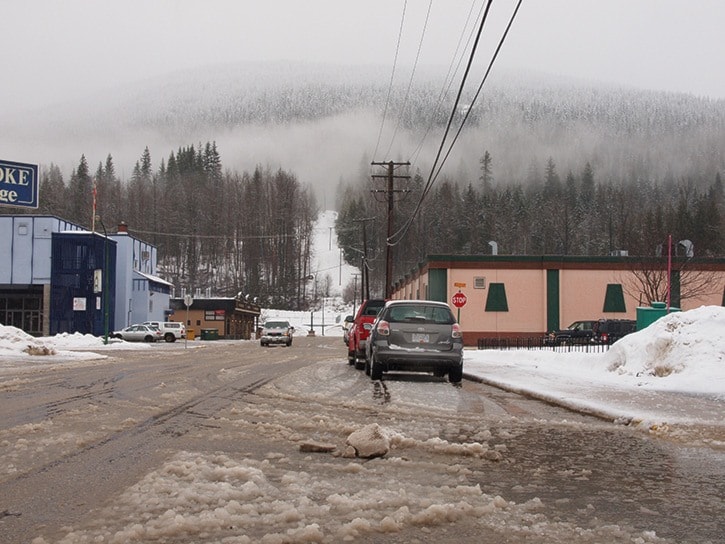Revelstoke seems to be enjoying an early spring this year. The roads have been free of snow for weeks and the little snow that has fallen hasn’t been sticking lately.
Is this the future of winter in Revelstoke? Will climate change make Februaries start looking more like March in the future?
Making weather predictions based on one low-snow year could be rather foolish – after-all, we’re only two years removed from one of the snowiest winters in recent memory in Revelstoke.
For the 106 years the City of Revelstoke has kept records, it’s snowed an average of 396.5 centimetres in town. Over the past 10 years, the average is 369 centimetres, with a high of 520 centimetres in 2010-11 and a low of 206 in 2004-5.
Even this winter was shaping up to be a very snowy one, with 145 centimetres in November and December of 2012 and 125 centimetres more snow in January.
And then February came and with it went the snow. Now, the streets are dry, the snowpack in town is dwindling and there’s even patches of grass showing up here and there.
Are snow-free or snow-less (as in less snow) winters the future? A report on the impacts of climate change released by the Columbia Basin Trust last fall sheds some light on what could happen.
The report, Climate change, impacts and adaptation in the Canadian Columbia Basin: From dialogue to action, takes an in depth look at the expected impact of climate change on the Columbia River Basin. Using data from the Pacific Climate Impacts Consortium (PCIC), the report looks at how warming climate will impact everything from growing season to tourism to the forest industry.
According to the report, winters will be warmer and wetter – meaning more snow at higher elevations and more rain in the valleys. The data from PCIC shows that for three decade period from 2041-70, the average temperature in Revelstoke will increase by about three degrees Celsius. Winter precipitation will increase by from 0-10 per cent.
The CBT report goes into a great deal of examination of what this will mean for the Basin. Glaciers will continue to shrink, and with that glacial runoff will eventually decrease, meaning lower water flow in many streams during summer. The spring melt will start earlier and peak flow will be reached earlier. There will be more freeze/thaw cycles as temperatures rise and more rain-on-snow and rain-on-frozen-ground events, which could lead to increased landslides.
In areas where snowfall increases, warmer temperatures and increased rain could result in more avalanches.
In practical terms, this will present a number of stresses. More freeze/thaw cycles will put more stress on roads. Darren Komonoski, the Public Works manager for the City of Revelstoke, said they are seeing more pot holes and popping in the roads due to freeze-thaw cycles. “More freeze-thaw creates more difficulties in road condition,” he said. “We have moderately increase our road patching budget for these types of activities.”
The snow that does fall will be heavier, putting a greater load on roofs. The CBT report recommends incorporating climate change effects into design guidelines for buildings, and infrastructure plans and maintenance. Environment Canada recently raised Revelstoke’s legal snow load requirements, which planning director John Guenther said could be seen as an impact of climate change.
The report also says costs related to snow removal will be reduced in lower elevations, but there could be increases from extreme weather events. It won’t snow as much, but when it does snow, it will snow a lot.
Komonoski said snow removal costs the city about $2,000 to $2,200 per centimetre. He also added that there are savings when more snow falls because the it’s cheaper per centimetre to clear 20 cm than 10 cm (unless there’s a huge snowfall, in which case the cost can go up). Based on his numbers, a metre less snow in a winter could mean the city saves $200,000 on its snow removal budget.
However, Komonoski said he isn’t willing to reduce the budget yet based on climate change predictions.
“I’m not prepared to do that because I have to provide access for emergency service and life safety,” he said. “That’s my number one goal and council has bought into that.”
Up in the mountains, shrinking glaciers can impact winter activities like skiing and snowmobiling, and higher snow levels will mean snowmaking will become even more important at low-elevation resorts to compensate. The CBT report also recommends resorts groom the slopes in summer so they don’t require as much snow to be skiable.
“I know one of the advantages we have if things stay warmer at lower elevations, the gondola gets us to 5–6,000 feet and that keeps us above the warm zone,” said Rob Elliott, the operations manager of Revelstoke Mountain Resort. “There is an advantage to the system that we have.”
He pointed out that the resprt has expanded up Mount Mackenzie over time. It used to be located on the lower mountain up to the existing day lodge. Then it was expanded with the old Powder Slug chair above the day lodge because the snow became less and less reliable lower down.
Now, the majority of the resort’s terrain is above 5,000 feet, positioning it well for future warming trends. Elliott said snowmaking was added on the lower mountain so people could ski down to the village all winter. He added they have talked about extending the system above the day lodge.
“Snowmaking, it’s a safety net for us,” he said. “If we don’t get the snow we can pump it out when it’s cold and make sure we have enough.”
The impacts of climate change extend far beyond winter. It will impact the spring melt, water supply, summer weather, the growing season, wildlife and the prevalence of airborne disease. Those impacts will be explored in a future article.
